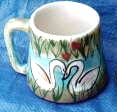Saturday, September 19, 2009
New Connections Website
This site is strictly for connecting U.S. crafter's and small business manufacturers with U.S. wholesale buyers.
Sunday, September 13, 2009
Casing
Monday, July 6, 2009
Plaster Mold Making Materials
There are so many ways to approach the subject of making molds, one almost has to be an expert on the materials available to make a decision.
For the most part, if you plan to make your finished product out of clay or clay slip, the material is pottery plaster.
Basically, you have 3 varieties of hardness. Pottery plaster, hydrocal and hydrostone.
Pottery plaster is the main stream for making ceramic molds. Of all the plasters, it’s the easiest to work with as it doesn’t run as fluid as the others. Easier to control leaks while making your mold.
If you’re able to find it in 50 or 100 pound bags, the name on the bag is #1 Pottery Plaster. If you don’t have access to the larger bags, you can find it in small quantities (although more expensive per pound) at the craft supply stores, under the name of Plaster of Paris.
I like working with Hydrocal (White Hydrocal) for ceramic molds for one reason only-it’s harder, just as absorbent and is more durable and longer lasting. People will tell you hydrocal is not suitable for ceramic molds. Let me tell you, I’ve had hundreds of satisfied customers, as well as using my own molds made of White Hydrocal.
Hydra-Stone or Hydrostone, is rock hard. The only time I’d consider this material for a mold is if I simply want finished pieces made of rubber. It is not absorbent. Hydrostone is most suitable as a finish product, like statuary.
When you want to make a finished product of a plaster material and it needs to be super sturdy and exposed to weather, something like stepping stones, there is yet another Hydra-Stone product called Hydra-Stone Super X. This is the cement material used in pavement. The only problem might be that it is a medium-dark gray.
In the middle is a variety of specialty plasters. One in particular, used strictly for figurines has a glass fiber in it.
Another specialty plaster is called Moulding Plaster. Don’t get this confused with pottery plaster. This Moulding plaster is strictly for finished pieces. Ultra-Cal, Tuf-Stone and Dry-Stone are the same. Not suitable for molds.
Good luck with all your mold making adventures and remember one thing from Judy - every mistake is a learning experience.
By the way, spilled plaster is no match for water. Don’t panic. If spilled on a concrete floor, it’s best to wait until it’s finished setting up. Then go after it with water splashed on it, and a flat edged tool. Just scrape it up. If it’s been spilled on carpet, add water and scoop it up as best you can. The portion that is left, that you can’t quite get to, will set up. If you’ve already added water to it, it has become diluted and weak. After it’s dry, you can come along with the vacuum and a stiff brush to help loosen it.
A rigid putty knife, about 3″ wide, is a helpful tool to keep handy. Especially when it comes to scraping up plaster from a smooth floor.
If you run into troubles, be sure to come back here and give me a holler. I’ll help.
Thursday, February 12, 2009
Suppliers
For my plaster molds, my favorite parting compound, I get from http://perma-flex.com
I've used their polyurethane parting compound for years. The secret is to apply with a soft paint brush, use a hair dryer to dry, while dabbing at puddles with a dry soft brush. I use a very soft, 2" paint brush. Using this method, you only have to apply one coat. You will be left with a fine film of something that feels like wax. I use a thin coat for every mold I pour off the master block.



